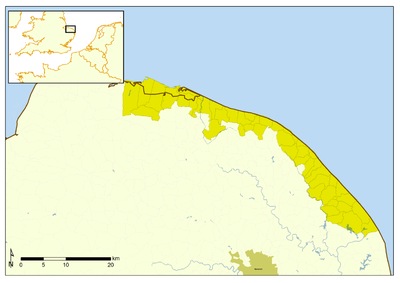Case study North Norfolk
North Norfolk FLAG case study
Contents
Introduction
The North Norfolk FLAG area has been home to a traditional small boat (largely) shellfish industry along this North Sea coastline of Eastern England (See Figure 1) for hundreds of years. North Norfolk is a sparsely populated area of Eastern England famed for its beautiful natural coastal environment. The coast is scattered with isolated picturesque fishing towns and villages that rely on a tourism sector underpinned by their coastal and fishing identity (North Norfolk FLAG, 2011). The fishing industry today employs over one hundred and forty people in the FLAG area [1] The North Norfolk coastal economy is made vulnerable by a strong dependence on (seasonal, low-wage) tourism and the close inter-linkages with the future of the fishing industry on this coast (both the risks and opportunities this presents) is well understood within the FLAG strategy [2]. There were 44 shellfish boats registered in the case study area in 2011 with the main species landed including brown crab, lobster, whelk and mussels [2]. The industry now also co-habits in this marine environment with major offshore energy developments with challenging local marine spatial planning and fisheries management implications.

Figure 1. North Norfolk FLAG, England (Source: VLIZ, 2014) Fisheries Governance OverviewResponding to the challenges facing this declining fisheries (including rising costs such fuel and licences, reduced number of new entrants, ageing demographic, increasing displacement of fishing grounds for conservation and commercial factors, climate change and poor market/supply chain conditions) the area secured FLAG status in 2011. FLAGs are funded by Axis 4 of the European Fisheries Fund (EFF) and are intended to support the sustainable local development of fishing industries and their related communities without increasing fishing effort. EFF is managed in the UK by the Marine Management Organisation (MMO), a non-departmental public body under the government Department for the Environment, Food and Rural Affairs [3]. North Norfolk is one of six English FLAGs. This funding programme has been developed in part owing to the acknowledgement at European Commission level that fisheries in smaller communities often make a considerable contribution to direct and indirect tourism, and cultural and social value [4]. Thus many of the FLAG projects focus on capitalising on these contributions through encouraging tourism and cultural fisheries related projects for example through fish festivals and heritage centres. In addition to securing a higher value for catch landed through marketing and supply chain innovation. Making fishing a more secure profession to attract the next generation of fishers has also been central to a lot of the FLAGs with investment fisher training, in port/ beach infrastructure and other health and safety elements on the boats. EFF will be replaced with the EMFF (European Maritime and Fisheries Fund) in 2015 with a particular focus on Integrated Marine Policy (IMP). In terms of governance North Norfolk District Council is the accountable authority for the FLAG and it reports to the MMO. The FLAG has a mixture of fishing industry (fisher/ fisherman’s association chairs), private and public sector stakeholders (including local authorities and national environment and conservation bodies). In terms of industry representation at a national level the fishers have the option of membership through the NFFO (National Federation of Fishermen’s Organisations); the inshore specific national association NUTFA (New Under Ten Fishermens Association); and the Shellfish Association of Great Britain (SAGB). At a local level six smaller fishing associations exist along this FLAG coast to provide local fisher representation and organisation. English inshore fisheries management (operating within six nautical miles) is policed and managed by the IFCAs (Inshore Fisheries and Conservation Authorities). The North Norfolk fleet work with the Eastern IFCA. The IFCAs co-operate with the MMO on several areas including fisheries enforcement and marine protected area management. IFCAs are funded through local authorities, but report to Defra. IFCAs replaced sea fisheries committees in April 2011, with an important expanded socio-economic remit to "lead, champion and manage a sustainable marine environment and inshore fisheries, by successfully securing the right balance between social, environmental and economic benefits to ensure healthy seas, sustainable fisheries and a viable industry" [3] Defra (2010) Inshore Fisheries and Conservation Authorities: vision, success criteria and high-level objectives. Department for Environment, Food and Rural Affairs, London.</ref>. The MMO is responsible for regulation and licensing of fishing in England. The duties and powers of the IFCAs and the MMO are set out in the Marine and Coastal Access Act 2009 (UK) and this takes account of the European Union instrument for fisheries management the recently reformed Common Fisheries Policy or CFP [5]. The Marine and Coastal Access Act, 2009 (UK) establishes the marine planning regime for the UK including underlying ICZM principles and the designation of a network of Marine Protected Areas (MPAs) (and in England Marine Conservation Zones (MCZs). Natural England (an Executive Non-departmental Public Body that is responsible for advising the UK Government on the natural environment) works with relevant stakeholders in helping inform Defra on their planning for these sites. UK fisheries management and marine planning is informed by Cefas (Centre for Environmental, Fisheries and Aquaculture Science), who are the executive agency responsible for carrying out research and monitoring of fish and shellfish stocks. [Note: This summary table provides a time-specific snap-shot of the issues observed in Winter 2013 during the research for this case study. The full context and detail of these issues can be read in the full GIFS report here: http://www.gifsproject.eu/images/pdf/GIFS_Report_Act1.2.pdf. Fisheries governance and the social processes that make up these structures are highly dynamic and this table should be read with that in mind.]
|